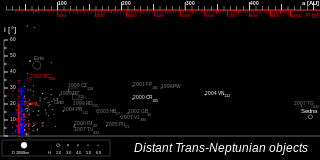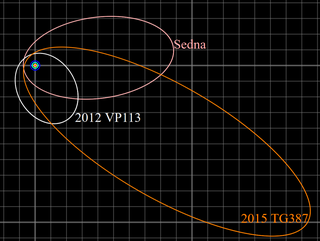In astronomy, the plutinos are a dynamical group of trans-Neptunian objects that orbit in 2:3 mean-motion resonance with Neptune. This means that for every two orbits a plutino makes, Neptune orbits three times. The dwarf planet Pluto is the largest member as well as the namesake of this group. The next largest members are Orcus, (208996) 2003 AZ84, and Ixion. Plutinos are named after mythological creatures associated with the underworld.

A trans-Neptunian object (TNO), also written transneptunian object, is any minor planet in the Solar System that orbits the Sun at a greater average distance than Neptune, which has an orbital semi-major axis of 30.1 astronomical units (au).

The scattered disc (or scattered disk) is a distant circumstellar disc in the Solar System that is sparsely populated by icy small Solar System bodies, which are a subset of the broader family of trans-Neptunian objects. The scattered-disc objects (SDOs) have orbital eccentricities ranging as high as 0.8, inclinations as high as 40°, and perihelia greater than 30 astronomical units (4.5×109 km; 2.8×109 mi). These extreme orbits are thought to be the result of gravitational "scattering" by the gas giants, and the objects continue to be subject to perturbation by the planet Neptune.

(612911) 2004 XR190, nicknamed Buffy, is a trans-Neptunian object, classified as both a scattered disc object and a detached object, located in the outermost region of the Solar System. It was first observed on 11 December 2004, by astronomers with the Canada–France Ecliptic Plane Survey at the Mauna Kea Observatories, Hawaii, United States. It is the largest known highly inclined (> 45°) object. With a perihelion of 51 AU, it belongs to a small and poorly understood group of very distant objects with moderate eccentricities.

Detached objects are a dynamical class of minor planets in the outer reaches of the Solar System and belong to the broader family of trans-Neptunian objects (TNOs). These objects have orbits whose points of closest approach to the Sun (perihelion) are sufficiently distant from the gravitational influence of Neptune that they are only moderately affected by Neptune and the other known planets: This makes them appear to be "detached" from the rest of the Solar System, except for their attraction to the Sun.
(445473) 2010 VZ98, provisional designation 2010 VZ98, is a trans-Neptunian object of the scattered disc, orbiting the Sun in the outermost region of the Solar System. It has a diameter of approximately 400 kilometers.

A sednoid is a trans-Neptunian object with a perihelion well beyond the Kuiper cliff at 47.8 AU. Only four objects are known from this population: 90377 Sedna, 2012 VP113, 541132 Leleākūhonua (2015 TG387), and 2021 RR205, but it is suspected that there are many more. All four have perihelia greater than 55 AU. These objects lie outside an apparently nearly empty gap in the Solar System and have no significant interaction with the planets. They are usually grouped with the detached objects. Some astronomers consider the sednoids to be inner Oort cloud objects (OCOs), though the inner Oort cloud, or Hills cloud, was originally predicted to lie beyond 2,000 AU, beyond the aphelia of the four known sednoids.

An extreme trans-Neptunian object (ETNO) is a trans-Neptunian object orbiting the Sun well beyond Neptune (30 AU) in the outermost region of the Solar System. An ETNO has a large semi-major axis of at least 150–250 AU. Its orbit is much less affected by the known giant planets than all other known trans-Neptunian objects. They may, however, be influenced by gravitational interactions with a hypothetical Planet Nine, shepherding these objects into similar types of orbits. The known ETNOs exhibit a highly statistically significant asymmetry between the distributions of object pairs with small ascending and descending nodal distances that might be indicative of a response to external perturbations.

2013 FS28 is an extreme trans-Neptunian object from the extended scattered disc on a highly eccentric orbit in the outermost region of the Solar System. It measures approximately 466 kilometers (290 miles) in diameter. The detached, extended scattered disc object belongs to the group of extreme trans-Neptunian objects. It was first observed on 16 March 2013, by American astronomers Scott Sheppard and Chad Trujillo at the Cerro Tololo Observatory in Chile.
(533560) 2014 JM80, provisional designation 2014 JM80, is a trans-Neptunian object from the scattered disc in the outermost Solar System, approximately 340 kilometers (210 miles) in diameter. It was discovered on 9 May 2010 by astronomers with the Pan-STARRS-1 survey at the Haleakala Observatory, Hawaii, in the United States. According to American astronomer Michael Brown, it is "possibly" a dwarf planet.
2014 FZ71 is a trans-Neptunian object, a scattered disc classified as a scattered and detached object, located in the outermost region of the Solar System. It was first observed on 24 March 2014, by a team led by American astronomer Scott Sheppard at the Cerro Tololo Inter-American Observatory in Chile. With its perihelion of almost 56 AU, it belongs to a small and poorly understood group of very distant objects with moderate eccentricities. The object is not a dwarf planet candidate as it only measures approximately 150 kilometers (93 miles) in diameter.
2014 FC72 is a trans-Neptunian object, classified as a scattered and detached object, located in the outermost region of the Solar System. It was first observed on 24 March 2014 by astronomers with the Pan-STARRS survey at Haleakala Observatory, Hawaii, United States. With its perihelion distant from Neptune, it belongs to a small and poorly understood group of objects with moderate eccentricities. It is estimated to measure 500 kilometers (300 miles) in diameter, assuming a low albedo.
2015 KQ174 is a trans-Neptunian object, both considered a scattered and detached object, located in the outermost region of the Solar System. The object with a moderately inclined and eccentric orbit measures approximately 154 kilometers (96 miles) in diameter. It was first observed on 24 May 2015, by astronomers at the Mauna Kea Observatories in Hawaii, United States.
(523635) 2010 DN93, provisional designation 2010 DN93, is a trans-Neptunian object from in the scattered disc located in the outermost region of the Solar System. It was discovered on 26 February 2010, by astronomers with the Pan-STARRS survey at Haleakala Observatory on the island of Maui, Hawaii, in the United States. Assuming a low albedo, the object is estimated at approximately 490 kilometers (300 miles) in diameter. It was numbered in 2018 and remains unnamed.

2013 FQ28 is a trans-Neptunian object, both considered a scattered and detached object, located in the outermost region of the Solar System. It was first observed on 17 March 2013, by a team of astronomers at the Cerro Tololo Inter-American Observatory in Chile. It orbits the Sun in a moderate inclined, moderate-eccentricity orbit. The weak dwarf planet candidate measures approximately 260 kilometers (160 miles) in diameter.
2013 SK100 is a trans-Neptunian object, both considered a scattered and detached object, located in the outermost region of the Solar System. The object with a moderately inclined and eccentric orbit measures approximately 135 kilometers (84 miles) in diameter. It was first observed on 29 September 2013, by astronomers at the Mauna Kea Observatories in Hawaii, United States.
The hypothetical Planet Nine would modify the orbits of extreme trans-Neptunian objects via a combination of effects. On very long timescales exchanges of angular momentum with Planet Nine cause the perihelia of anti-aligned objects to rise until their precession reverses direction, maintaining their anti-alignment, and later fall, returning them to their original orbits. On shorter timescales mean-motion resonances with Planet Nine provides phase protection, which stabilizes their orbits by slightly altering the objects' semi-major axes, keeping their orbits synchronized with Planet Nine's and preventing close approaches. The inclination of Planet Nine's orbit weakens this protection, resulting in a chaotic variation of semi-major axes as objects hop between resonances. The orbital poles of the objects circle that of the Solar System's Laplace plane, which at large semi-major axes is warped toward the plane of Planet Nine's orbit, causing their poles to be clustered toward one side.
2014 ST373 (prov. designation:2014 ST373) is a trans-Neptunian object and a detached object from the outermost region of the Solar System. With a perihelion of 50.2 AU, it belongs to the top 10 minor planets with the highest known perihelia of the Solar System. and is neither a scattered disc nor an extreme trans-Neptunian object. It measures approximately 370 kilometers (230 miles) in diameter and was first observed on 25 September 2014, by astronomers using the Dark Energy Camera (DECam) at Cerro Tololo Inter-American Observatory in Chile.








